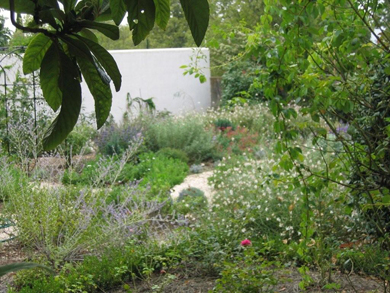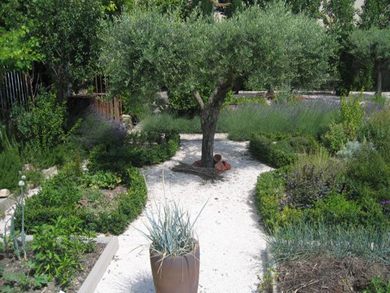Duncan’s garden in Caromb in the Vaucluse
Duncan wrote this description of his garden in February 2012. He was a great supporter of the concept of a Directory of Members’ Gardens and one of the first to open his garden to visits from members and friends. He was also passionate about the protection of wildlife and championed the idea of publicising those gardens which are recognised as a refuge by the Ligue pour la Protection des Oiseaux. Duncan died unexpectedly in April 2017 but his partner and friends feel sure that he would have wanted his garden to continue to be cared for and to remain open to visitors. MGF member Frances Horne has volunteered to open the garden for visits by appointment – see contact details below.
General Description: The garden comprises approximately 600 sq m of land in the centre of a 14th century stone village surrounded by vineyards and orchards. The mas dates back to the mid 1850s and the land originally formed part of an agricultural small holding however the property was subsequently used as a restaurant. I inherited a hard-packed gravel area used as an outdoor terrace and a weed-infested grassed children’s playing area.
Soil and climate: Work on the current garden commenced in 2007. The only vegetation was three olive trees, a vine, four cypress trees, a bay and a neflier. The soil is generally workable with a roughly neutral pH – no doubt a result of the garden’s former history. Carpentras is on official record as having the greatest extremes of temperature in France recording -10ºC in March and 43ºC in summer. Despite being sheltered by stone walls, the garden also suffers the impact of the mistral blowing down the Rhône corridor. There is no well or forage (although a right to flood the property from a nearby lake exists!) so rain water is collected and stored and supplemented by automatic watering from the town supply for newly planted areas and the potager.
Plants and Projects: I have tried to select plants naturally suited to our Mediterranean climate and have included space in the design for a herb garden and four raised vegetable beds. There is also a separate pool terrace with planting in pots. Excluding the potager, all the plant names and planting dates are recorded so that I can monitor successes and failures. The garden is run on strict organic principles (apart from the occasional use of town water) and waste material is either shredded for mulch, composted or burned so no material leaves the site. A small barrel pond together with insect hotels and shelters have helped to develop the garden’s eco-system.
My main disappointment is not to have given greater early focus to disguising unattractive new walls. I also remain intolerant of poor performing specimens, which means that areas of the garden evolve fairly rapidly!
Visits: The garden is most interesting from late April to late June and again in the autumn. Please send an email to make an appointment.
Email: Frances Horne
Garden recognised as a refuge by the Ligue pour la Protection des Oiseaux
![]()




